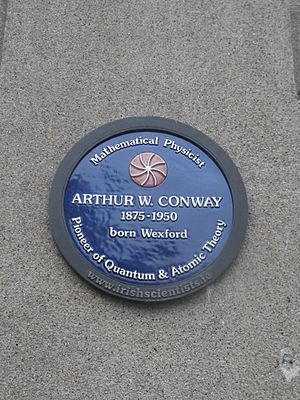Arthur W. Conway facts for kids
Arthur William Conway FRS (born October 2, 1875 – died July 11, 1950) was a very important Irish mathematician and mathematical physicist (a scientist who uses math to understand how the world works). He wrote one of the first books about Albert Einstein's theory of relativity. He also helped put together two books of William Rowan Hamilton's important math papers. From 1940 to 1947, he was the head of University College Dublin.
Life and Career

Arthur Conway was born in Wexford, Ireland. He went to school at St Peter's College, Wexford. In 1892, he started at University College, Dublin. He earned his first university degree (BA) in 1896 from the Royal University of Ireland. He got great marks in subjects like Latin, English, Mathematics, and Natural Philosophy (an old name for science).
In 1897, he earned his advanced university degree (MA) with top marks in math. He then went to Corpus Christi College, Oxford in England to continue his studies. In 1901, he became a professor of Mathematical Physics at University College Dublin. He held this job until 1940. He also taught for a short time at St. Patrick's College, Maynooth.
Arthur Conway married Agnes Christina Bingham on August 19, 1903. They had three daughters and one son.

One of Conway's students was Éamon de Valera, who later became a very important leader in Ireland. Conway taught de Valera about quaternions, which are a special type of number system used in math. De Valera really liked this topic and even did his own research on it. Later, when de Valera became Taoiseach (the Prime Minister of Ireland), he asked Conway for help. He wanted Conway to help set up the Dublin Institute for Advanced Studies, a place for advanced research.
Conway's first published works, from 1903, were about the theory of electricity and magnetism. He is well-known for using a special type of math called biquaternion algebra to understand Einstein's theory of relativity. In 1915, he published a book called "Relativity." He also published an article in 1911 and later said he had developed some ideas before another scientist, Ludwik Silberstein. Another scientist, George Temple, supported Conway's claim in his book 100 Years of Mathematics.
In 1947, Conway used quaternions to describe how things turn in a special kind of space called hyperbolic space. The next year, he published ideas about how his math could be used in quantum mechanics (the science of very tiny particles).
In 1918, Arthur Conway ran for election as a politician in two areas: South Londonderry and the National University. He came in second place in both elections.
Arthur Conway kept studying math and theoretical physics. He spent a lot of time studying the work of William Rowan Hamilton. With J. L. Synge, he helped edit the first book of Hamilton's math papers. With A. J. McConnell, he edited the second book. Conway was also very active at University College Dublin. He became the Registrar (a senior administrator) and held that job until he was chosen as president in 1940. He retired from being president of UCD in 1947. After he passed away, some of his writings were put together and published in 1953.
He was invited to speak at the ICM (a big meeting for mathematicians) in Toronto in 1924, in Zurich in 1932, and in Oslo in 1936. He was also the President of the Royal Irish Academy from 1937 to 1940.
In October 1975, to celebrate 100 years since his birth, University College Dublin held a special event called the AC Conway Memorial Mathematical Symposium. Famous speakers like Roger Penrose and Ian Sneddon attended.
In a tribute after Conway's death, scientist E.T. Whittaker called him "the most distinguished Irish Catholic man of science of his generation."
Books
- 1915: Relativity, G. Bell & Sons (Edinburgh Mathematical Tracts No. 3) via Internet Archive
- 1931: The Mathematical Papers of Sir William Rowan Hamilton: Volume 1, Geometrical Optics, Cambridge (edited with J L Synge)
- 1940: The Mathematical Papers of Sir William Rowan Hamilton: Volume 2, Dynamics, Cambridge (edited with J L Synge)

